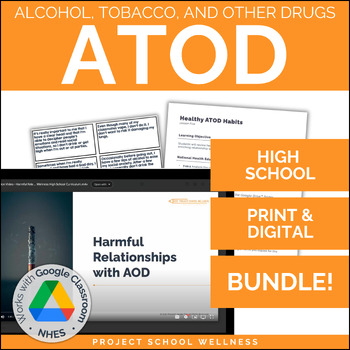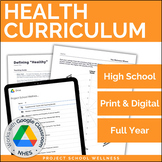ATOD and Substance Use Bundle | Alcohol, Tobacco, Vaping, and Other Drugs Unit
- Zip

Products in this Bundle (8)
showing 1-5 of 8 products
Bonus
Also included in
- Immerse your high school students in a transformative health and wellness journey with our comprehensive, skills-based health curriculum. Designed as a fully prepared, done-for-you program, this high school health and wellness curriculum focuses on cultivating core health skills that seamlessly intePrice $525.00Original Price $776.50Save $251.50
Description
In this Alcohol, Tobacco, and Other Drugs (ATOD) unit and lesson plan bundle, students will learn how to navigate alcohol, tobacco, vaping, and other drugs. The goal of this unit is not to tell students what they should or shouldn’t do in relation to ATOD. Rather, the intention is to equip students with functional knowledge and skills that will empower them to build a healthy relationship with ATOD as they critically assess their relationship with ATOD and make ATOD-related decisions that enhance their well-being.
***This done-for-you lesson plan is ready for digital, in-person, or hybrid learning!***
Your Students Will
- Define the cultural perceptions of alcohol, tobacco, and other drugs (ATOD) in their lives and examine their personal ATOD perceptions.
- Identify common reasons why people use drugs (including alcohol, nicotine, and marijuana) and assess how the reality of using drug(s) compares to the expectation.
- Access valid information about an assigned drug and design a compelling presentation to teach relevant information to their peers.
- Customize the ATOD Relationship Assessment Tool (ARAT) and utilize it to analyze a person’s relationship with ATOD.
- Review healthy ATOD habits to practice that can help build an enriching relationship with ATOD and keep them safe if they choose to use ATOD.
- Create a self-help guide for navigating a harmful relationship with ATOD.
- Analyzed a person in the media’s relationship with ATOD and examined how the media messages may influence viewers’ relationship with ATOD.
- Create a peer advocacy project that authentically relates to their peers and shares practical advice for nurturing a relationship with ATOD that enriches well-being.
National Health Education Standards met in this lesson:
- 2.12.2 Analyze how the culture supports and challenges health beliefs, practices, and behaviors.
- 2.12.5 Evaluate the effect of media on personal and family health.
- 2.12.6 Evaluate the impact of technology on personal, family, and community health.
- 2.12.7 Analyze how the perceptions of norms influence healthy and unhealthy behaviors.
- 2.12.8 Analyze the influence of personal values and beliefs on individual health practices and behaviors.
- 3.12.2 Use resources from home, school, and community that provide valid health information.
- 4.12.1 Use skills for communicating effectively with family, peers, and others to enhance health.
- 5.12.7 Evaluate the effectiveness of health-related decisions.
- 6.12.1 Assess personal health practices and overall health status.
- 7.12.1 Analyze the role of individual responsibility for enhancing health.
- 7.12.2 Demonstrate a variety of healthy practices and behaviors that will maintain or improve the health of self and others.
- 7.12.3 Demonstrate a variety of behaviors to avoid or reduce health risks to self and others.
- 8.12.1 Utilize accurate peer and societal norms to formulate a health- enhancing message.
- 8.12.4 Adapt health messages and communication techniques to a specific target audience.
This Done-For-You lesson plan comes with:
- Instruction Video - Watch the provided teaching videos to help you navigate the complexities of mental health with confidence, comfort, and clarity.
- Teaching Guide - A detailed lesson plan requiring minimal prep and NO extra planning
- Editable Teaching PowerPoints
- Grading Rubrics - For quick and meaningful assessments
- Free updates for life!
>>> Need more high school skills-based lesson plans? - Check out our High School Curriculum
Distance Learning Compatible
This resource is hosted on Google Drive and can easily be transferred to your Google Classroom. If applicable, this resource features a Google Slides edition of the student worksheet and a Google Forms version of the learning station activity. Learn how on our blog!
Looking For More
- Free skills-based health lesson plans - Download Now!
- Free skills-based health workshop - Sign Up Here!
- Skills-Based Health Educators Facebook Group - Join!
- Health education resources and ideas - Check it out!
Google Drive Disclaimer
Upon purchase, you’ll receive a link to access your resource on Google Drive. Using Google Drive is the easiest way for us to edit and update resources. This allows us to quickly respond to feedback, share new features, and make sure this product is serving you well! If you have any issues with this, please email janelle@projectschoolwellness.com for assistance.






